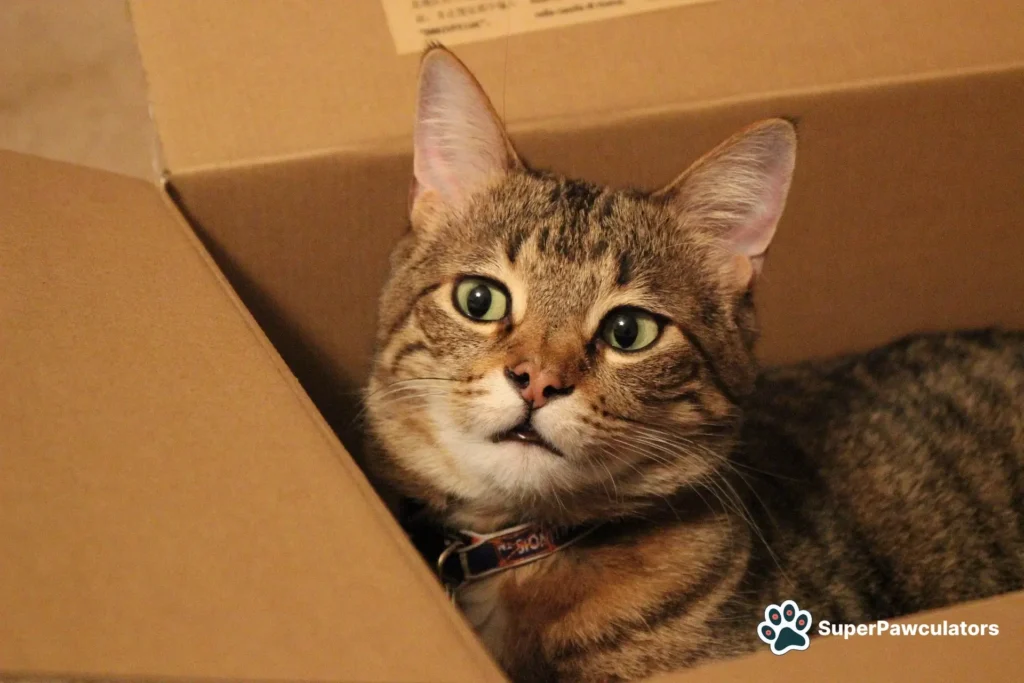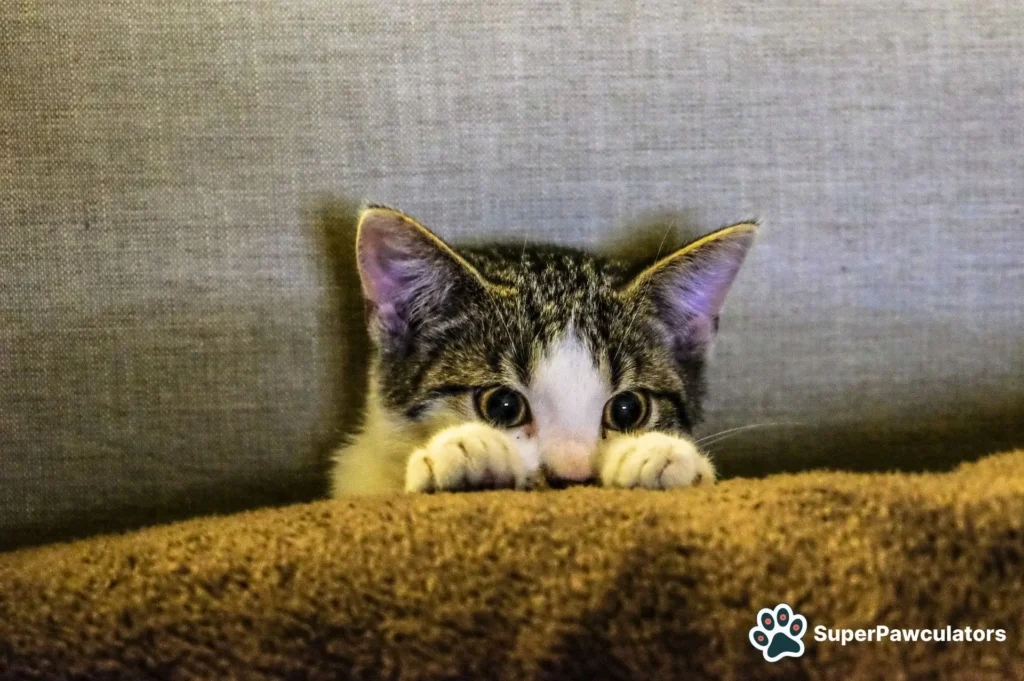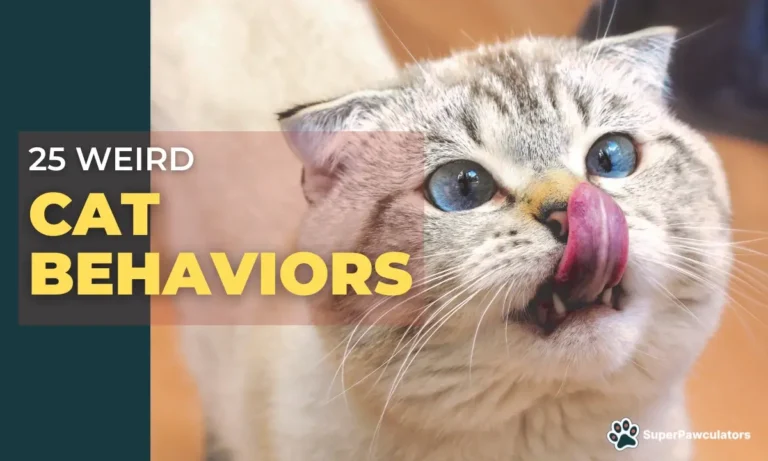Cats are full of surprises, and their weird cat behaviors can leave even the most experienced pet owners confused. From running around in the middle of the night to sitting in tiny boxes, these strange habits might seem random, but they all have a reason. Many of these behaviors come from their instincts or ways of communicating. In this blog, we’ll explain 25 weird cat behaviors to help you understand your feline friend better. Get ready to uncover the secrets behind their quirky actions!
The Midnight Zoomies
Ever wondered why your cat suddenly transforms into a speed demon at 3 AM? These random bursts of energy, known as “zoomies” or Frenetic Random Activity Periods (FRAPs), are completely normal feline behavior. In the wild, cats are most active during dawn and dusk, their natural hunting times. Your domestic cat maintains this instinctive behavior pattern, leading to those crazy midnight sprinting sessions around your house. This energy release helps them maintain their hunting skills and burn off excess energy.

Knocking Things Off Surfaces
That moment when your cat makes direct eye contact while slowly pushing your favorite mug off the table isn’t just them being mischievous. This behavior stems from their natural hunting instincts and curiosity about cause and effect. Cats use their paws to test if objects are prey, and the movement of falling items triggers their predatory drive. Additionally, they quickly learn that this behavior gets your attention, making it a reliable way to interact with their human companions.
Bringing You “Gifts”
Finding dead mice or birds at your doorstep might be unsettling, but your cat considers it a generous gesture. This behavior is rooted in their maternal instincts – mother cats teach their kittens to hunt by bringing them prey. When your cat brings you these “presents,” they’re treating you as family, attempting to teach you hunting skills, or showing off their prowess. It’s their way of contributing to the household and sharing their successful hunts.
The Box Obsession
Your cat’s inexplicable love for boxes, regardless of size, isn’t just adorable – it’s instinctual. Boxes provide cats with a sense of security and comfort, reminiscent of their wild ancestors’ need for safe, enclosed spaces. These cardboard havens offer thermal insulation and serve as excellent observation posts. Studies show that boxes can actually reduce stress in cats by giving them a private space where they feel protected from potential threats.

Chattering at Birds
That distinctive chattering sound your cat makes while watching birds through the window is a fascinating behavior. This jaw-quivering movement, accompanied by chirping sounds, might be a manifestation of their predatory instinct and frustration at not being able to catch the prey. Some experts believe it might also be an instinctive “killing bite” reflex, while others suggest it’s a way cats express excitement or attempt to mimic their prey’s sounds.
Face Rubbing Everything
When your cat rubs their face against you or objects, they’re not just showing affection – they’re marking their territory. Cats have scent glands on their faces, particularly around their cheeks and chin. This behavior, known as “bunting,” releases pheromones that mark you and your belongings as part of their territory. It’s both a sign of ownership and affection, creating a familiar environment that makes them feel secure and comfortable.
The Post-Potty Sprint
The mysterious post-litter box zoomies might seem bizarre, but there’s logic behind this behavior. After using the bathroom, cats often experience a sense of relief and euphoria, leading to a burst of energy. This behavior might also be a survival instinct from their wild ancestors, who would quickly leave their waste site to avoid attracting predators. The sudden sprint helps them distance themselves from their scent trail.
Sleeping in Weird Positions
Those contortionist-like sleeping positions your cat adopts aren’t just for Instagram-worthy photos. Cats are incredibly flexible, and these strange positions often help them feel secure while remaining ready for action. When cats sleep in exposed positions, showing their belly, it indicates they feel completely safe in their environment. These positions also help them regulate their body temperature and stretch their muscles even while resting.

Water Bowl Shenanigans
If your cat insists on pawing at their water bowl or drinking from running taps, they’re not just being difficult. This behavior stems from their natural instinct to avoid standing water, which could be contaminated in the wild. Moving water appears fresher and more appealing to cats. Some cats also paw at their water to better see its surface or create movement, making it easier to gauge the water level.
The Slow Blink
That dreamy, slow blink your cat gives you is actually a sign of deep trust and affection, often called a “cat kiss.” When cats feel safe and comfortable, they’ll close their eyes slowly in your presence, showing they trust you enough to be vulnerable. This behavior is a form of non-verbal communication that cats use to show they’re relaxed and friendly. Try slow blinking back to strengthen your bond.
Loafing Position
The famous “cat loaf” position, where cats tuck their paws under their body, serves multiple purposes. This position helps cats conserve body heat while keeping their vital organs protected. It’s also a sign that your cat feels safe and comfortable, as they wouldn’t expose their belly area if they felt threatened. When cats loaf, they’re usually in a state of contentment, ready to doze off but still alert to their surroundings.
Kneading or “Making Biscuits”
That rhythmic pushing motion cats make with their paws, often called “making biscuits,” originates from kittenhood. Kittens knead their mother’s belly to stimulate milk production while nursing. Adult cats continue this behavior when they’re feeling content and comfortable, similar to how humans might have self-soothing behaviors from childhood. It’s also a way for cats to mark territory through scent glands in their paws.

The Elevator Butt
When your cat raises their rear end while being petted, they’re not just being quirky. This position, known as “elevator butt,” is actually a compliment to you. It’s a sign of trust and happiness, similar to how cats greet each other in friendly situations. This behavior also allows cats to present their scent glands, located near their tail, for social bonding and marking their trusted companions.
Sitting on Your Stuff
Finding your cat sitting on your laptop, book, or paperwork isn’t just about seeking attention. Cats are attracted to items that carry your scent and warmth. They also instinctively gravitate towards elevated surfaces that allow them to observe their surroundings. When they choose your belongings to sit on, they’re both claiming these items as part of their territory and trying to be close to your scent.
The Sideways Hop
The peculiar sideways hop, often accompanied by an arched back and puffed tail, is known as the “crab walk” or “Halloween cat” pose. This behavior usually occurs when cats are startled or excited, causing them to appear larger and more intimidating to potential threats. It can also be part of play behavior, especially in younger cats, serving as practice for defensive moves they might need in real situations.
Hiding in Small Spaces
Your cat’s tendency to squeeze into tiny spaces isn’t just about playing hide and seek. This behavior is rooted in their wild instincts, where small, enclosed spaces provided safety from predators. These tight spots make cats feel secure and protected, while also giving them a vantage point to observe their surroundings. The pressure from confined spaces can also have a calming effect, similar to how weighted blankets work for humans.

The Pre-Vomit Carpet Run
When cats feel nauseous, they often run around frantically before vomiting, preferably on carpet or rugs. This behavior might seem counterintuitive, but it’s driven by instinct. In the wild, cats would seek soft ground to cover their illness, preventing predators from detecting their vulnerability. The carpet’s texture provides better traction and absorbency, making it a preferred spot for this unfortunate but natural process.
The Bathroom Escort
If your cat follows you to the bathroom, they’re not just being nosy. This behavior stems from their social nature and protective instincts. In the wild, cats are vulnerable while eliminating, so they look out for each other during these moments. When your cat follows you, they’re both keeping you company and standing guard. Plus, the bathroom is often an intriguing place with interesting smells and sounds.
Whisker Testing
When cats push their faces into narrow spaces or openings, they’re using their whiskers to measure the space. These sensitive tactile hairs help cats determine if they can fit through openings without getting stuck. This behavior, known as “whisker testing,” is crucial for spatial awareness. If you notice your cat doing this before entering a space, they’re simply ensuring safe passage through their environment.
The Catnip Craze
Your cat’s bizarre reaction to catnip isn’t just random silliness. This response is actually caused by nepetalactone, a compound that triggers a euphoric response in cats’ brains. When cats smell catnip, they might roll around, drool, or become extremely playful. This reaction is hereditary, affecting about 50-70% of cats. The behavior typically lasts 10-15 minutes and is completely harmless, serving as natural enrichment for indoor cats.

Twitching While Sleeping
Those adorable twitches, paw movements, and whisker wiggles during sleep aren’t random. Like humans, cats experience REM sleep, during which they might act out their dreams. These movements often mirror hunting behaviors, suggesting they’re dreaming about catching prey or playing. This twitching is completely normal and helps maintain their physical and mental well-being through sleep cycles.
The Paw Dip Test
When cats cautiously dip their paw into water before drinking, they’re not being fussy. This behavior helps them gauge the water’s depth and location without putting their face too close. It’s also a way to test the water’s safety, as standing water could be dangerous in the wild. Some cats prefer to drink water this way because it gives them better control over their water intake.
Scratching Around Food
If your cat scratches around their food bowl before or after eating, they’re following an ancestral instinct to bury leftover food. In the wild, this behavior would hide evidence of a meal from potential predators or prey. Even well-fed house cats retain this instinct. Some cats also scratch to mark their feeding territory through scent glands in their paws.
Showing Their Belly
When cats expose their bellies, it’s not always an invitation for belly rubs. This position actually shows ultimate trust since the belly is a cat’s most vulnerable area. However, many cats will react defensively if you try to touch their exposed belly because this trust signal isn’t necessarily permission for physical contact. It’s similar to a human smile – friendly, but not an invitation for immediate physical interaction.

The Sudden Freeze
Sometimes cats will suddenly freeze mid-action, appearing statue-like for several seconds. This behavior often occurs during play or exploration and is related to their hunting instincts. When cats detect something interesting, they’ll pause to better assess the situation and plan their next move. This momentary stillness helps them focus their senses and decide whether to pounce or retreat.
Conclusion:
Cats are unique animals, and their weird cat behaviors are part of what makes them so special. By learning the reasons behind their actions, you can build a stronger bond and create a happier environment for them. Whether it’s their playful habits or instinctive behaviors, understanding these quirks helps you see the world through their eyes. The next time your cat does something strange, you’ll know it’s just their way of being themselves!

